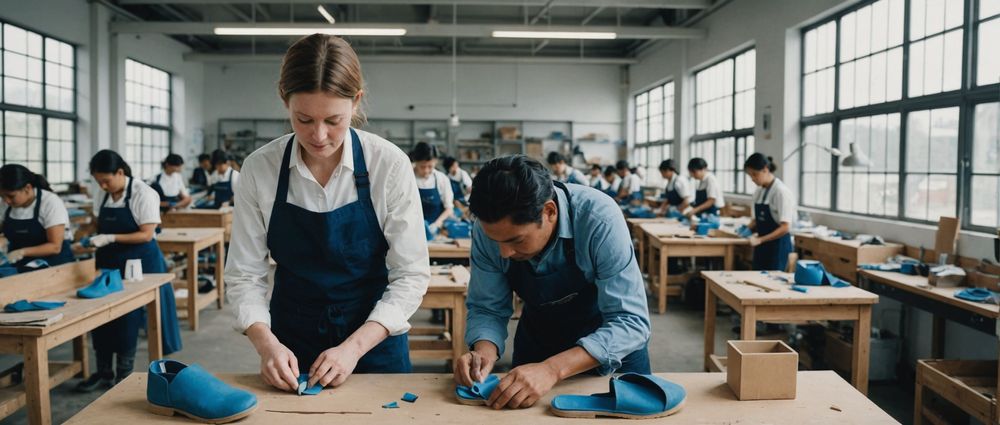Sustainable shoes are designed with the environment in mind, promoting ethical production and materials while minimizing waste. The core of sustainability in footwear encompasses the sourcing of eco-friendly materials, ethical labor practices, and the overall lifecycle of the shoe from production to disposal. In this article, we’ll delve into the key elements that define a sustainable shoe, including materials, manufacturing processes, durability, and end-of-life considerations.
1. Eco-Friendly Materials
A shoe’s sustainability begins with the materials used in its construction. Eco-friendly materials are integral in reducing the environmental impact of footwear. Sustainable shoes often utilize organic cotton, recycled plastics, natural rubber, and even innovative materials like mushroom leather or algae-based foams. These materials are usually sourced from renewable resources or recovered waste, making them significantly less harmful to the environment compared to traditional materials. Here are some commonly used sustainable materials:
- Organic cotton
- Recycled PET (from plastic bottles)
- Natural rubber
- Hemp
- Mushroom leather
By opting for these materials, brands not only reduce their dependency on fossil fuels or toxic chemicals but also lower their carbon footprint considerably.
2. Ethical Manufacturing Processes

It’s not just what goes into a shoe that matters—how it’s made is equally important. Ethical manufacturing practices ensure fair labor conditions, safe working environments, and fair wages for workers. Sustainable shoe brands often adhere to stricter labor standards and are transparent about their supply chains. They may also employ local artisans, which supports community economies and reduces transportation emissions. Companies committed to sustainability often prioritize the following:
- Fair wages for workers
- Safe working conditions
- Minimizing waste in the production process
- Using energy-efficient practices
- Transparent sourcing
The commitment to ethical practices ultimately contributes to a more sustainable and equitable footwear industry.
3. Durability and Longevity
A sustainable shoe isn’t just about how it’s made; it must also stand the test of time. Footwear designed for durability decreases the risk of premature disposal, which in turn minimizes waste. When a shoe can withstand wear and tear, it reduces the need for frequent replacements and cuts down on overall consumption. Durable shoes often feature high-quality materials, reinforced stitching, and timeless designs that can remain stylish through various fashion cycles. To achieve longevity, sustainable shoes may include:
- Quality craftsmanship
- Timeless designs that transcend trends
- Resilient materials that resist wear
- Repairable components
- Comfortable fits to enhance usability
Emphasizing durability not only benefits consumers but also supports environmental efforts by reducing waste in landfills.
4. End-of-Life Considerations

What happens to a shoe at the end of its lifecycle is crucial in determining its sustainability. Shoes designed for a circular economy can be re-used, recycled, or composted, preventing them from contributing to landfill waste. Some brands facilitate take-back programs, where customers can return their old shoes for recycling or refurbishment. Others use biodegradable materials that break down over time without causing harm. The following practices contribute to end-of-life sustainability:
- Take-back programs
- Use of biodegradable materials
- Recycling facilities to process old footwear
- Designs that encourage easy disassembly for recycling
- Educational initiatives on responsible disposal
By considering the end-of-life options, brands can create a more circular economy that reduces the environmental impact of footwear.
5. Transparency and Consumer Awareness
Finally, sustainability is associated with transparency. Brands that disclose their sourcing, manufacturing processes, and material compositions empower consumers to make informed decisions. Sustainable shoes are often labeled as such, giving eco-conscious buyers an opportunity to support responsible brands. Issues such as “greenwashing,” where brands claim sustainability without backing it up, are increasingly coming to light. Awareness leads to accountability and encourages brands to improve their practices. As consumers, we can promote sustainable practices by:
- Researching brands and their claims
- Supporting local and ethical businesses
- Opting for minimalistic designs that last longer
- Engaging in conversations about sustainability
- Deepening knowledge on sustainable materials and practices
Consumer education fosters a more sustainable marketplace, pushing brands to uphold high standards in environmental responsibility.
Conclusion
In conclusion, identifying a sustainable shoe involves evaluating its materials, manufacturing processes, durability, end-of-life options, and the transparency of the brand. A truly sustainable shoe promotes eco-friendly materials, ethical labor, durability, and responsible disposal methods. By choosing sustainable shoes, consumers can contribute to a positive environmental impact and support responsible practices in the footwear industry. Every purchase can be a step towards a more sustainable future.
FAQs
1. What materials are typically used in sustainable shoes?
Sustainable shoes often incorporate eco-friendly materials such as organic cotton, recycled plastics, natural rubber, and innovative materials like mushroom leather or hemp.
2. How can I tell if a shoe brand is sustainable?
Look for transparency in the brand’s sourcing and manufacturing practices, certifications of ethical labor, and whether they utilize eco-friendly materials. Reviews and independent assessments can also help verify their claims.
3. What can I do with old shoes?
You can donate them, recycle them through brand take-back programs, or look for local organizations that refurbish and reuse shoes. Compostable options can also be disposed of in compost bins if they meet specific criteria.
4. Are sustainable shoes more expensive?
While sustainable shoes may have a higher upfront cost due to better materials and ethical practices, they often provide better durability and longevity, making them more cost-effective in the long run.
5. How does wearing sustainable shoes impact the environment?
Wearing sustainable shoes helps reduce waste, lowers carbon emissions, and supports ethical labor practices, all of which contribute positively to the environment and society.



